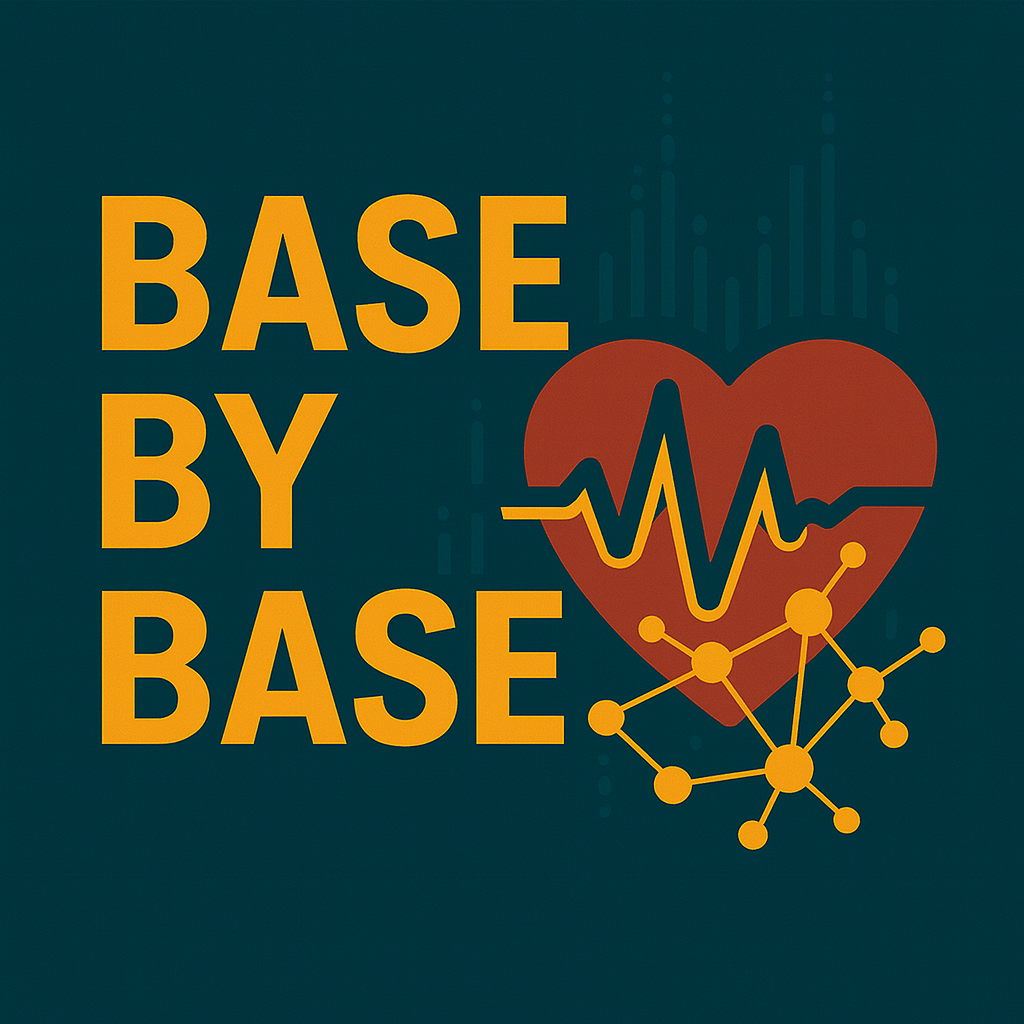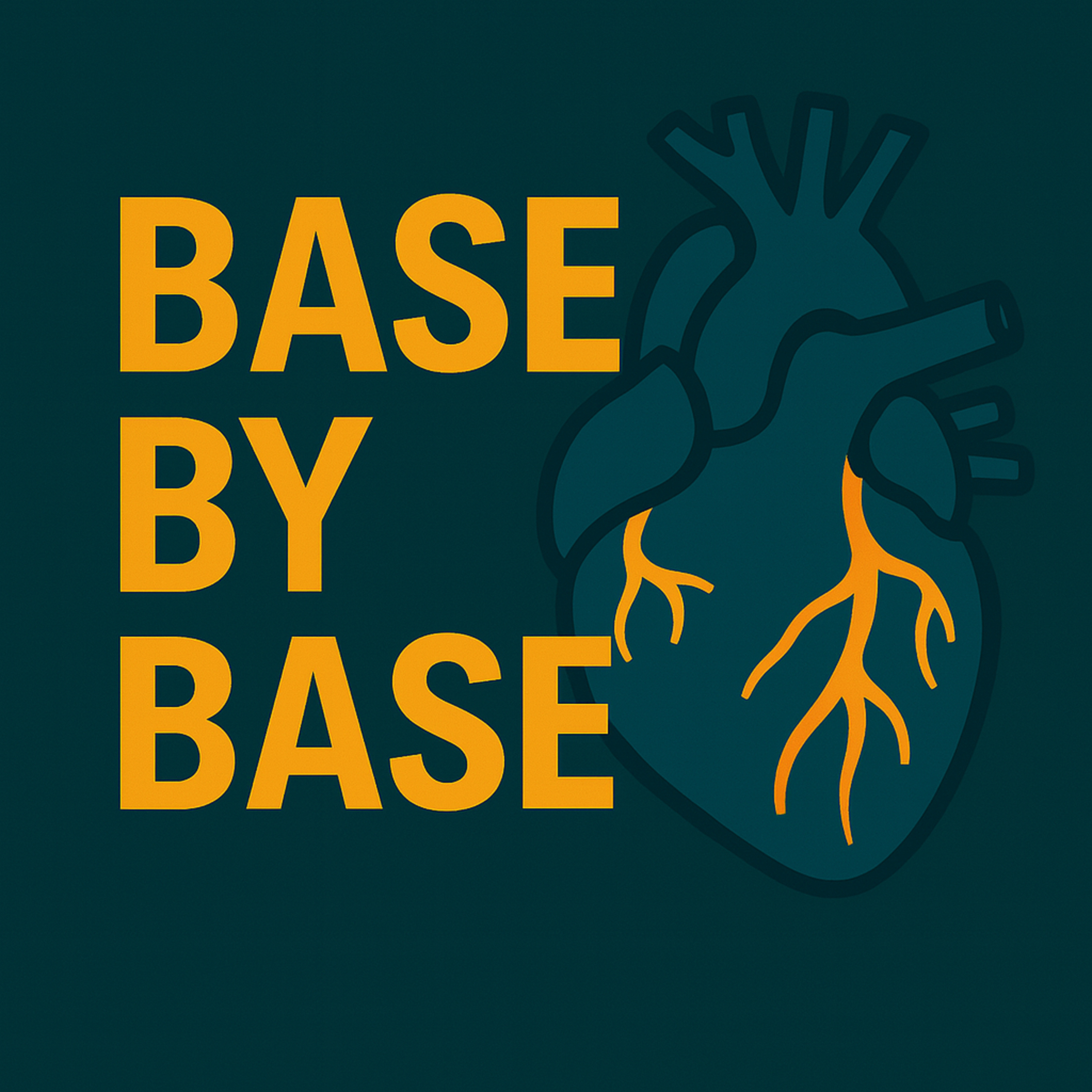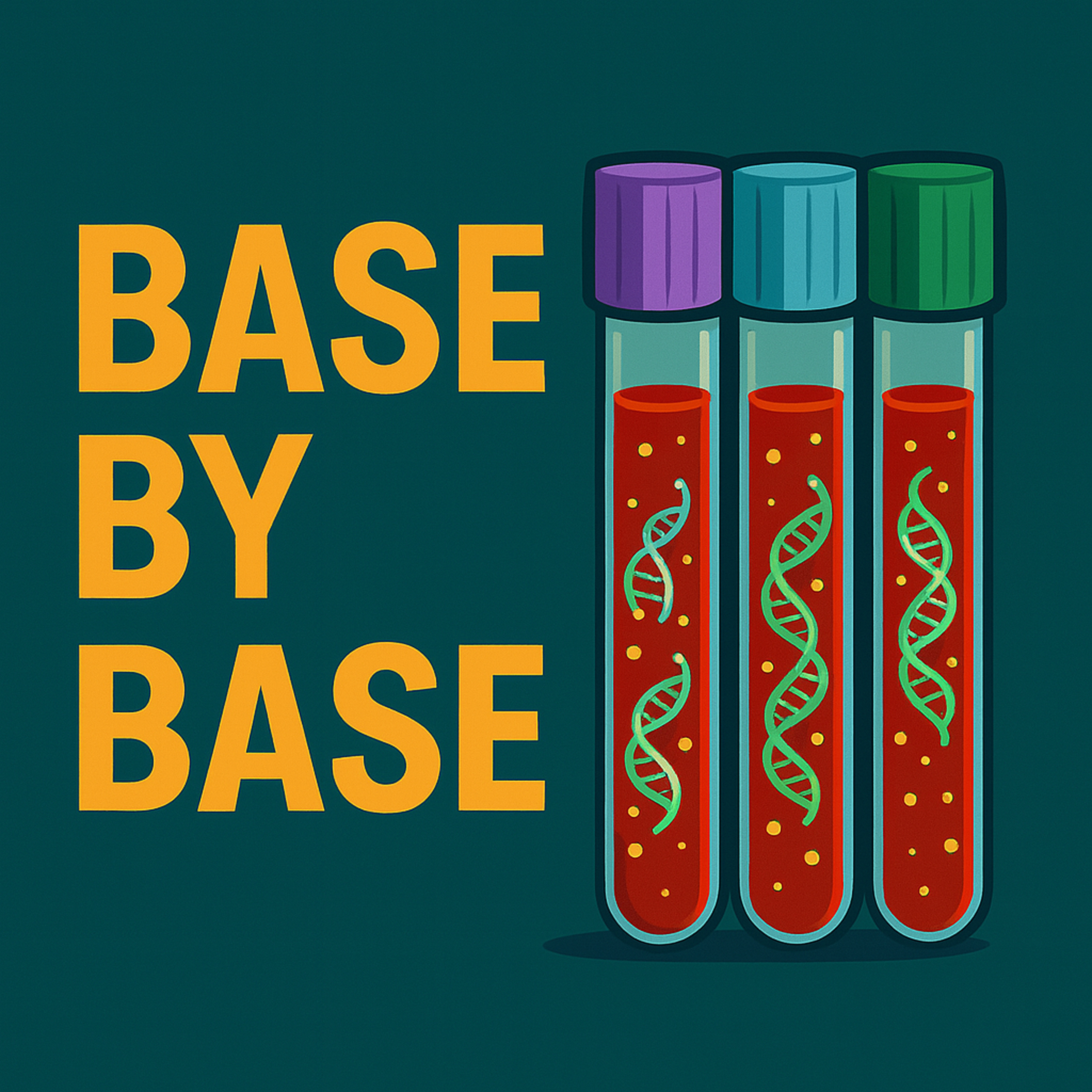Episode Transcript
[00:00:00] Speaker A: Foreign.
Welcome to Bass by Bass, the paper cast that brings genomics to you wherever you are.
Okay. Imagine for a second a heart that's just constantly out of rhythm.
[00:00:23] Speaker B: Yeah.
[00:00:24] Speaker A: Skipping, fluttering, maybe racing, really unpredictably.
[00:00:27] Speaker B: Yeah.
[00:00:28] Speaker A: That's actually the reality for, get this, nearly 60 million people around the world who live with atrial fibrillation, or af.
[00:00:34] Speaker B: It's staggering, isn't it? The most common heart arrhythmia globally.
[00:00:38] Speaker A: Exactly. And it's not just, you know, uncomfortable palpitations. AF seriously impacts quality of life and, well, it can lead to really serious.
[00:00:45] Speaker B: Things like stroke, devastating complications.
[00:00:47] Speaker A: Right. But even though it's so common, our grasp on what's really going on deep down the molecular level, the tiny gears driving it and finding effective new treatments, it's been, well, surprisingly patchy.
[00:01:00] Speaker B: It has.
[00:01:01] Speaker A: So it makes you wonder how much of AF is actually sort of hardwired in our genes. And can we get a much clearer idea of who's really at risk? Maybe even find totally new ways to prevent or treat it if we look beyond, say, just one population group?
[00:01:15] Speaker B: That's such a critical point and it really highlights an urgent global need, doesn't it? The numbers for AF are actually going up, especially, you know, as the world's population gets older. Ah, okay. So this trend really underlines why, digging into its fundamental causes. The why and the how isn't just an academic exercise.
[00:01:35] Speaker A: Right. It has real world consequences.
[00:01:37] Speaker B: Absolutely. Understanding it better directly impacts how well we can predict it, how we can prevent it and how we deliver treatments that actually work. It could genuinely make a difference for millions of people.
[00:01:47] Speaker A: So today, our deep dive is celebrating a really huge piece of research, one that pushes our understanding forward quite a bit, giving us a much clearer map of this complex condition.
[00:01:59] Speaker B: Indeed. And we should definitely take a moment to acknowledge the incredible teamwork involved here. Shuai and a very extensive team from places like the University of Pennsylvania, Perelman School of Medicine, Karolinska Institute in Sweden, Imperial College London. Just a massive collaboration. Their rigorous work has really, truly expanded our view of the genetic and molecular side of atrial fibril.
A fantastic example of what international collaboration can achieve.
[00:02:27] Speaker A: Definitely. Now we know, things like diet, lifestyle, environmental factors, they play a big part in af.
But the genetic side, that contribution is being recognized more and more as a major piece of the puzzle.
[00:02:41] Speaker B: That's right.
[00:02:42] Speaker A: Previous studies, the big genome Wide association studies, or TWS, they've done great work. Found over 100 risk losing specific DNA spots linked to higher risk.
[00:02:52] Speaker B: Yep. Laid some important groundwork and this is.
[00:02:56] Speaker A: The key thing, right? Most of those studies, they were done mainly in people of European ancestry, and.
[00:03:00] Speaker B: That'S the crux of the issue. A major barrier to really getting the full picture. These population specific studies, they're valuable, no doubt, but they can miss genetic variants that maybe have smaller effects on their own, but add up. Oh, and more importantly, they might completely miss genetic markers that are unique to certain ancestries or even ones that are shared across different groups, but just weren't looked for properly everywhere.
[00:03:22] Speaker A: So it's like mapping a continent by only exploring one country.
[00:03:25] Speaker B: Exactly. You get similar, some data, sure, but you miss the bigger picture. So this study really aimed to overcome that by combining massive cross population genetic data with insights from proteins, from proteomics.
[00:03:38] Speaker A: Okay, so the mission was clear. Perform this huge cross population Geabis meta analysis, dig up new genetic links, find causal risk factors and maybe, just maybe, improve how we predict AF risk and find new treatment options.
[00:03:51] Speaker B: Precisely.
[00:03:53] Speaker A: So how did they actually do it? Let's get into the methodology. This wasn't just any study, was it? We're talking over 2 million individuals involved, including what, 168,000 AF cases.
[00:04:04] Speaker B: It's an incredible number. The scale is just immense. And the process itself was super careful, done in phases.
Phase one was a big European meta analysis, almost 154,000 AF cases right there. That gave them a really strong starting.
[00:04:17] Speaker A: Point, a solid foundation.
[00:04:19] Speaker B: Right.
Then phase two, they expanded outwards, pulled in data from East Asian, South Asian, African and admixed American populations.
That deliberate cross population strategy is what makes this so powerful and frankly more equitable.
[00:04:36] Speaker A: And handling all that diverse data must have been a challenge. What kind of techniques did they use?
[00:04:41] Speaker B: Oh, highly sophisticated stuff. Rigorous quality control first off, absolutely vital when you're pooling data like this. Then imputation, which is like a clever statistical way to fill in any missing genetic bits on the map.
[00:04:54] Speaker A: Okay.
[00:04:54] Speaker B: And they used advanced statistical methods, things like metal, for combining results across studies, getting a more robust overall signal and ldsc, which helps understand the overall genetic architecture. Basically how all those tiny genetic differences add up to influence AF risk.
[00:05:10] Speaker A: So pulling the signal from the noise, essentially.
[00:05:12] Speaker B: Exactly. Identifying those precise genetic links across all these different groups.
[00:05:16] Speaker A: But they didn't stop just at finding the links. Right. You mentioned these downstream deep dives to really understand what it all meant.
[00:05:22] Speaker B: Absolutely. That's where the real insights often come from. First they did gene prioritization. Think of it like bringing in specialist detectives. They used six different methods, six different angles to figure out which gene at each risky Location was most likely the culprit.
[00:05:37] Speaker A: Moving beyond just the location to the actual gene involved.
[00:05:40] Speaker B: Precisely. Then, pathway enrichment. They looked at which biological pathways or functions were linked to these prioritized genes. Using big databases like Reactome and Gene Ontology, they could see. Okay, are genes involved in say, muscle function or electrical signaling popping up more.
[00:05:58] Speaker A: Often than expected, giving clues about the underlying biology of af?
[00:06:02] Speaker B: Exactly.
Then came Mendelian randomization or minr. This is a really clever one.
[00:06:08] Speaker A: I've heard of this. It uses genetics like a natural experiment.
[00:06:11] Speaker B: That's a great way to put it. Because our genes are randomly assigned at birth, they act like unbiased tools. Mr. Uses this to figure out if something actually causes something else, not just if they tend to happen together.
[00:06:23] Speaker A: Cutting through that correlation. Causation confusion.
[00:06:26] Speaker B: Precisely. So they used Mr. Here to check for causal links between things like lifestyle habits or specific proteins floating in the blood and the actual risk of developing af.
[00:06:36] Speaker A: Okay, makes sense.
[00:06:37] Speaker B: And finally, bringing it back to practical use, they developed and tested risk scores, a polygenic risk score or pgs, based on all the genetic findings and also a new protein score, PRO S. The big question was, can combining all this genetic and protein info actually make us better at predicting who's likely to get af?
[00:06:56] Speaker A: Wow, that is incredibly sterile. Okay, the moment of truth. After all that work, what do they find? Hit us with the big results.
[00:07:02] Speaker B: The results are pretty stunning. This massive cross population effort nailed down 525 genetic loci, specific spots in the genome linked to to AF with high confidence.
[00:07:12] Speaker A: 525. Okay, that's a lot.
[00:07:14] Speaker B: It is. But here's the kicker. The really groundbreaking part. 379 of those were completely new, never reported before.
[00:07:20] Speaker A: Wow. Almost 400 new genetic connections. It's not just adding details that's like redrawing the map entirely.
[00:07:27] Speaker B: It really is. It points towards potentially hundreds of new biological avenues. New mechanisms we hadn't even really considered for AF before.
[00:07:36] Speaker A: Were these new discoveries spread evenly or did the cross population approach reveal differences?
[00:07:42] Speaker B: Great question. And yes, it really highlighted the value of diversity. Most loci, 483 were found in the European data, which reflects the larger sample size there historically. But crucially, because they looked broader, they also found 29 loci in East Asians, five in Africans and two in admixed Americans. It shows this approach finds both shared and population specific signals.
[00:08:06] Speaker A: And were there any genes that popped up everywhere?
[00:08:08] Speaker B: Yes, two well known players, PITX2 and ZFHX3, they showed up as significant across all four population groups studied.
[00:08:16] Speaker A: Ah, so reinforcing their key role universally.
[00:08:19] Speaker B: Absolutely. Solidifies them as really fundamental risk factors, regardless of your ancestry. They also found six specific variants, SNPs, that had a particularly large effect. Odds ratios over 1.3, meaning more than.
[00:08:30] Speaker A: A 30% increased risk for people with those variants.
[00:08:33] Speaker B: Exactly. A significant jump. These were new genes like Srcs3, Plld1, Agbl4, and again, good old Pitx2.
[00:08:42] Speaker A: Okay, clear impact there. What about the biology? Did the pathway analysis just confirm what we thought we knew, or were there surprises?
[00:08:49] Speaker B: A bit of both. Which is often the best outcome. It definitely reinforced known pathways. Muscle contraction, heart development, cardiogenesis. Things that make intuitive sense for af. Right, but, and this is really exciting, they also uncovered other pathways getting more emphasis, like the cellular response to tgfa, transforming growth factor beta.
[00:09:08] Speaker A: Tgfa isn't that involved in tissue scarring? Fibrosis.
[00:09:12] Speaker B: Exactly. And fibrosis in the heart is strongly linked to af.
So finding this pathway highlights potential drug targets that could maybe tackle that structural remodeling. They also found pathways involved in how arteries develop and importantly, how heart cells communicate electrically.
[00:09:26] Speaker A: Ah, the electrical coupling central to rhythm.
[00:09:30] Speaker B: Absolutely. These new pathways open up entirely new angles for research and potentially new types of treatments down the line.
[00:09:36] Speaker A: That's fascinating. Did looking across different populations reveal anything about how AF interacts with other health problems like comorbidities?
[00:09:45] Speaker B: Yes. Another key insight, looking at genetic correlations. Basically the genetic overlap between diseases. They found significant differences between Europeans and Africans for common circulatory issues.
Things like abdominal aortic aneurysm and deep vein thrombosis. The genetic link between these conditions and AF wasn't the same across ancestries.
[00:10:06] Speaker A: So the genetic relationship between AF and other conditions might vary depending on ancestry.
[00:10:12] Speaker B: It suggests that. Yeah. It means we need more nuanced population aware approaches. A risk factor or connection in one group might not hold true or might work differently in another.
[00:10:21] Speaker A: Makes sense. Okay, what about the things we can potentially change?
Modifiable risk factors.
[00:10:26] Speaker B: The Mr. Analysis really solidified some things here. It provided strong causal evidence linking AF risk to high BMI, type 2 diabetes, high blood pressure and smoking.
[00:10:36] Speaker A: So confirming these aren't just associated, they likely cause increased risk.
[00:10:40] Speaker B: That's what the mister Suggests. Yeah.
And interestingly, it also strengthened the case for some factors where the evidence was a bit mixed before, like dyslipidemia, that's cholesterol levels, alcohol use and being sedentary.
[00:10:55] Speaker A: Providing a clearer picture for public health messages.
[00:10:58] Speaker B: Definitely stronger evidence to really push those lifestyle interventions.
[00:11:02] Speaker A: And did they Pinpoint any specific proteins that might be causally involved. Potential new drug targets.
[00:11:08] Speaker B: Yes, very promising findings here. They identified 28 proteins circulating in the blood that seemed to have a causal link to AF.
Some, like a protein called ING1, were linked to lower risk.
Others, like ATXN2L to higher risk. Okay, and here's the really exciting part. Seven of these proteins, there are already drugs targeting them either in clinical trials or even approved for other diseases.
[00:11:31] Speaker A: Whoa, really? So potential drug repurposing?
[00:11:33] Speaker B: Exactly. It hints that we might be able to reuse existing safe drugs for af, which could massively speed up getting new treatments to patients. None are approved for AF yet, but it's a very promising lead.
[00:11:44] Speaker A: That would be huge. But I heard there was also a kind of paradox. Something odd they found with a common heart mark. NT probnp.
[00:11:52] Speaker B: Ah, yes. This was a really intriguing one. It makes you stop and think. Observational studies consistently show that NT probnp levels are high in patients who have af. It's used as a marker of heart strain.
[00:12:04] Speaker A: Right. Standard practice.
[00:12:05] Speaker B: But this study looking at genetic liability to af, found it was associated with lower circulating NT probnp levels.
[00:12:12] Speaker A: Lower? That's the opposite of what doctors say.
[00:12:15] Speaker B: Exactly. It's a paradox. So what could it mean?
Well, the genetic evidence suggests that maybe the high NT Probnp seen in patients is actually a consequence of having AF'd. The heart is strained because of the arrhythmia, rather than the NT probnp itself being a primary cause of the af.
[00:12:31] Speaker A: Ah, so the high levels are a result, not a cause.
[00:12:34] Speaker B: That's what this genetic evidence hints at. It's a fantastic reminder that correlation isn't causation and highlights why these genetic methods like Mr. Are so valuable for untangling these complex relationships. Maybe targeting NT probnp directly isn't tackling the root cause.
[00:12:49] Speaker A: That really shifts the perspective. Okay, so pulling it all together, all this new genetic info, the protein insights, did it actually improve our ability to predict who might get af?
[00:13:00] Speaker B: Yes, and this is potentially transformative for the clinic. The polygenic risk score the PGS built from this huge cross population study was much better at predicting AF than previous scores. It achieved an AUC. That's a measure of accuracy of 0.780.
[00:13:15] Speaker A: Which is pretty good for a complex disease.
[00:13:18] Speaker B: Very good. But here's the really exciting bit. When they combined that genetic score with their new protein score, PRO S, the predictive power jumped significantly.
[00:13:28] Speaker A: Oh, much better.
[00:13:29] Speaker B: The combined score reached an AUC of 0.823. That multi OLMIC approach using both genes and proteins clearly outperformed using either one alone.
[00:13:39] Speaker A: Wow. 0.823 is impressive. That suggests we could get much better at identifying high risk people earlier on.
[00:13:44] Speaker B: Precisely enabling more personalized targeted prevention strategies.
[00:13:48] Speaker A: So it feels like this deep dive really marks a major step forward. Not just finding more genes, but showing the power of looking broadly across different populations. Right.
[00:13:56] Speaker B: A more complete picture that sums it up perfectly. It's refined our map of AF genetics like never before. Finding all those new loci, seeing how they play out across ancestries. It hammers home why we absolutely need more diversity in genetic research.
[00:14:11] Speaker A: For equitable discovery.
[00:14:12] Speaker B: Exactly. To make sure the insights benefit everyone.
And the new pathways identified, like tgff, they offer really promising new avenues for drug development. Plus the stronger confirmation of those modifiable risk factors. That just reinforces the critical role of public health efforts. Weight, blood pressure, smoking. Basic but vital.
[00:14:33] Speaker A: And that nt prob ENP finding is a great reminder to question assumptions, isn't it? Biology is complex.
[00:14:39] Speaker B: It really is. It shows observed links aren't always causal and we need these sophisticated methods to tease things apart.
[00:14:44] Speaker A: Which all seems to point towards a future of more personalized medicine for heart conditions.
[00:14:48] Speaker B: Absolutely. That enhanced risk prediction using both genes and proteins. It really opens the door to tailoring prevention and treatment much more precisely to the individual.
Identifying risk early, intervening smartly, that's the goal.
[00:15:02] Speaker A: Now, while this study is clearly groundbreaking, we should touch on limitations. The sample sizes for non European groups were still smaller. Right. So more research is needed there.
[00:15:12] Speaker B: Definitely. While they did a great job including diverse groups, there's still an imbalance in statistical power. We absolutely need more large scale studies focusing on underrepresented populations to make sure the findings are truly global. And of course this is mainly computational work in silico, meaning we need follow up lab work, functional studies to really confirm these biological mechanisms in living cells and systems and see how these genes and proteins actually work day to day.
[00:15:39] Speaker A: Understood. So overall, this deep dive pulled together genetic discovery, that causal inference piece with Mr. And multi omic data in a really unprecedented way, pushing our understanding of AF forward significantly.
[00:15:51] Speaker B: Without a doubt, this comprehensive approach hasn't just given us a treasure trove of new genetic loci and pathways, but it's also shown how combining genetic and protein data can seriously boost our ability to predict AF risk and ultimately guide better prevention and treatment down the road.
[00:16:06] Speaker A: So the final thought then is what does this really mean for the future of personalized cardiovascular medicine? How might these powerful multi ohmic tools change how we tackle complex diseases like AF Worldwide, making healthcare truly tailored to each person. This episode was based on an Open Access article under the CCBY 4.0 license. You can find a direct link to the paper and the license in our episode description. If you enjoyed this, follow or subscribe in your podcast app and leave a five star rating. If you'd like to support our work, use the donation link in the description. Thanks for listening and join us next time as we explore more science base by base.
[00:16:45] Speaker B: Sam.




